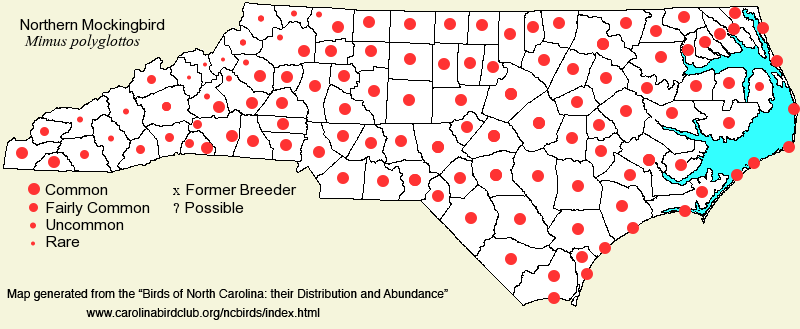 |  |
|
Northern Mockingbird - Mimus polyglottos MIMIDAE Members: | Search Common: Search Scientific: |
|
|
|||||||
| General Comments | The Northern Mockingbird may well be the most conspicuous of our songbirds, at least in the breeding season. This species nests across the southern two-thirds of the United States, and is slowly moving northward, as they quickly adapt to open yards and towns. It is essentially a permanent resident in most areas, including North Carolina; there is an imperceptible migration, though flocks have been seen along the coast in fall. It also nests across the state but is not common in most of the mountains. Elsewhere, downstate, it can scarcely be missed in a morning of birding. Habitats tend to be open sites near man, such as farmyards, residential areas, towns, and cities; they also occur in some early successional habitats, like brushy fields and clearcuts. In winter, mockingbirds are well known for guarding bushes and trees covered in berries, such as hollies; they are very aggressive in attempting to drive away flocks of Cedar Waxwings and American Robins trying to "steal" their (the mockingbird's) winter stash. | ||||||
| Breeding Status | Breeder | ||||||
| NC BRC List | Definitive | ||||||
| State Status | |||||||
| U.S. Status | |||||||
| State Rank | S5 | ||||||
| Global Rank | G5 | ||||||
| Coastal Plain | Permanent resident, with only a poorly seen migration, noticeable mainly along the coast in fall. Common to very common, and conspicuous, across the entire region, even along the Outer Banks. Peak counts: | ||||||
| Piedmont | Permanent resident; migration imperceptible. Common to very common across the region, except slightly less numerous in the foothill ranges. Peak counts: | ||||||
| Mountains | Permanent resident; migration imperceptible. Fairly common to common below about 2,000 feet, such as in the southwestern-most counties. Fairly common up to about 3,000 feet; uncommon up to about 3,500 feet. One record from Carvers Gap at Roan Mountain (over 5,000 feet) on 22 Sep 2004. Peak counts: | ||||||
| Finding Tips |
None needed. **** | ||||||
| Attribution | LeGrand[2023-03-27], LeGrand[2012-09-27], LeGrand[2011-12-12] | ||||||
| NC Map Map depicts all counties with a report (transient or resident) for the species. | Click on county for list of all known species. |
| NC Breeding Season Map Map depicts assumed breeding season abundance for the species. |  |